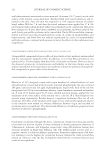OXIDATIVE STABILITY OF COSMETIC EMULSIONS WITH PLANT EXTRACTS 193 skin-care products. The citied examples refer to various seaweed and terrestrial plant extracts which were investigated and proven to possess the capacity to improve oxi- dative stability of cosmetic emulsions so far. SARGASSUM MUTICUM (SARGASSACEAE) Sargassum muticum is a large brown seaweed originated from Japan (33). A previous study investigated the effects of S. muticum extract on stability of oil-in-water sun cream. The concentration of the extract in cream was 0.15 wt %, and oxidative stability was assessed by measuring the peroxide and p-AV. Findings of the study indicate that addition of natural extracts corresponded to less oxidation than creams without antioxidants or with tocopherol (31). Observed effects are likely resulting from the presence of polysaccharide fucoidan and phlorotannins, as a specifi c class of phenolic compounds from marine sea- weeds (21,33). The addition of S. muticum in sun cream formulation initially switched color to dark brown in comparison to α-tocopherol, and this product was also tested for consumer acceptance by performing a sensory test and determination of color parame- ters after 9 mo of storage. The fi ndings indicate that consumers well accepted sun cream prepared with the S. muticum extract, while there were no oscillations in colorimet- ric values visually observed (31). Phlorotannins and algal polysaccharides possess signifi cant antioxidant properties, which enable them to be potentially good candidates for pharmaceutical and cosmetic formulations (21). Ethanol extract of S. muticum collected in Spain was incorporated into avocado cream as well as cosmetic oils, massage oil, and shower oil. In addition, crude extract produced by autohydrolysis of this species was added to avocado cream. Examination of stability of those preparations revealed that ethanol extract exerted the highest potential to inhibit lipid oxidation in cream (93.96%), followed by shower oil (58.58%) and massage oil (13.90%). Furthermore, S. muticum extract obtained by autohydrolysis was also effi cient in inhibition of oxidation in cream (84.37%), but less than that in ethanol extract (21). Figure 2. Improving oxidative stability of cosmetic emulsions with plant extracts.
JOURNAL OF COSMETIC SCIENCE 194 ULVA LACTUCA (ULVACEAE) Ulva lactuca is a green macroalga which belongs to the phylum Chlorophyta (34). Macroalgae or seaweeds represent a valuable source of active components that might be exploited in the pharmaceutical industry. They contain high amounts of carbohydrates (up to 60%) and medium/high amounts of proteins (10–47%), lipids (1–3%), and mineral ash (7–38%) (35). Ulva spp. has high protein content as well as phenolics, chlorophyll, and carotenoids with free radical scavenging potential (36,37). Powder extract of U. lactuca was used as an ingredient in sun cream. The stability of the cream was tested by determina- tion of the p-anisidine and PV, as well as the TOTOX value. Finding of the study indi- cates that Ulva lactuca led to a reduction in lipid oxidation during storage (21). FUCUS VESICULOSUS (FUCACEAE) Fucus vesiculosus is a brown seaweed. A previous study investigated the antioxidant effi ciency of two F. vesiculosus extracts, water and 80% ethanol. Freeze-dried extracts were added to facial cream in concentrations of 0.05 and 0.1%. Oxidative stability of the formulation was tested after 42 d by determining peroxide levels and volatile compounds (pentanal, hexanaol, heptanal, octanal, nonanal, t2-heptenal, t-2-octenal, 2-ethyl-1-hexanol, 1-penten-3-one, and 2-pentylfuran). Both types of extract were able to attenuate lipid peroxidation how- ever, ethanol extract appeared to be more effi cient. In support of the observed fi ndings, it was previously reported that antioxidant effi ciency in preparation strongly depends on an- tioxidant capacity of extracts tested in vitro and phenol content (2,38–40). One group of authors assessed the potential of water and acetone extracts of F. vesiculosus to preserve qual- ity of skin-care emulsions. The results indicate that both extracts with a concentration of 2 mg/g of emulsion acted protectively against thermo-oxidation. Nevertheless, only aqueous extract exerted activity against photo-oxidation, probably as a consequence of higher con- tent of carotenoids (2). Fucus vesiculosus and other brown algae have been in the focus of re- search interest because of a dominant presence of phlorotannins and polysaccharides (fucoidans and laminarin) with great biological activities. In that sense, these potent anti- oxidant components are probably the most responsible for maintaining the quality of emul- sions (41). F. vesiculosus was shown to be a superior antioxidant in comparison to other seaweed species such as Laminaria because of higher polyphenolic content (42). Addition of Fucus sp. in sun cream formulations improved oxidative stability and appears to be well accepted by consumers because of the absence of signifi cant color changes in the product over time (31). Literature data suggest that the color of the products was almost unaffected in emulsions formulated with both algal extracts Fucus sp. and S. muticum (31). Based on previous work assessing the potential of F. vesiculosus, it might be concluded that this plant species is able to delay degradation of unsaturated functional lipids in cosmetic emulsions, thus representing a useful ingredient for skin-care products. CASTANEA SATIVA (FAGACEAE) Castanea sativa is a species of chestnut belonging to Fagaceae family which has been rec- ognized for importance both in the nutrition and cosmetic industry. It contains a lot of dietary fi bers, as well as vitamins, minerals, and polyphenol quercetin (43–45). Chestnut
Purchased for the exclusive use of nofirst nolast (unknown) From: SCC Media Library & Resource Center (library.scconline.org)

























































































































